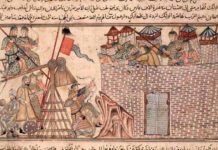
Early period of the history of Japan, characterized by the building of a new national capital and the consolidation of a centralized state. In 710 the court and government moved to the new capital of Heijo-kyo, now Nara, which was laid out in a grid pattern in the Chinese style and which was situated so as to dominate the economically rich and politically crucial region of Yamato.
In Nara the institutional changes inaugurated by the Taika Reforms reached their maturity in the ritsu-ryo system. This was a pattern of highly centralized government modelled on Chinese practice: the whole country was divided into a hierarchy of administrative units and all rice land belonged to the state but was distributed to cultivators according to need. Taxation was to be levied uniformly and roads were constructed to facilitate the movement of goods and officials. However, in spite of the rational appeal of the Chinese system, making it work in Japan, which was much less economically developed and had an existing structure of powerful aristocratic families, was difficult, especially since so many tax exemptions were allowed to placate courtiers and powerful religious institutions.
The impact of the Tang dynasty of China on Nara Japan was incalculable. Official contacts were maintained by the despatch from Japan of embassies, each consisting of several hundred men, and by a stream of monks and students. Chinese historical writing had its counterpart in the two Japanese histories written at this time, the Kojiki (712) and the Nihon Shoki (720), which presented an official justification of the position of the emperors. Chinese characters were still the only form of writing known in Japan, and they were used to write down Japanese words in the Man’yoshu, the first anthology of native poetry in Japanese literature. As the eastern terminus of the Silk Route, Japan also received many treasures from across Asia, some of which survive at the Shosoin Treasure House in Nara.
Buddhism was firmly ensconced as the state religion in the Nara period. It was devoutly patronized by Emperor Shomu, who reigned from 724 to 749 and devoted the resources of the state to produce the Todai-ji, a huge wooden temple that housed an equally huge statue of the Buddha. It was both a temple to protect the state and a statement to the Buddhist world overseas that Japan was committed to Buddhism. It was inaugurated in 752 by his daughter, Empress Shotoku, who maintained his policy of support for the Buddhist establishment in spite of the expense, until her death in 770.
Shotoku’s successor, Emperor Konin, attempted to rein in the expenditure and lax administration of his predecessors, but tax revenues continued to fall as peasants absconded from state lands and rebellions continued to challenge the authority of the state. Taxes on state lands were higher than on tax-exempt private estates, so people (and economic power) shifted to the latter, especially when great families began opening up virgin lands, which were also tax-exempt, after 743. Partly because of the heavy influence of the Buddhist institutions established in Nara, and because of factional strife at court, in 784 the city was abandoned for a new capital further to the north at Nagaoka. This was, however, short-lived, and in 794 a further move was made to Heian-kyo, the modern city of Kyoto, which remained the official capital until 1868. The centralized, aristocratic society developed in the Nara period continued to evolve in the succeeding Heian period.







